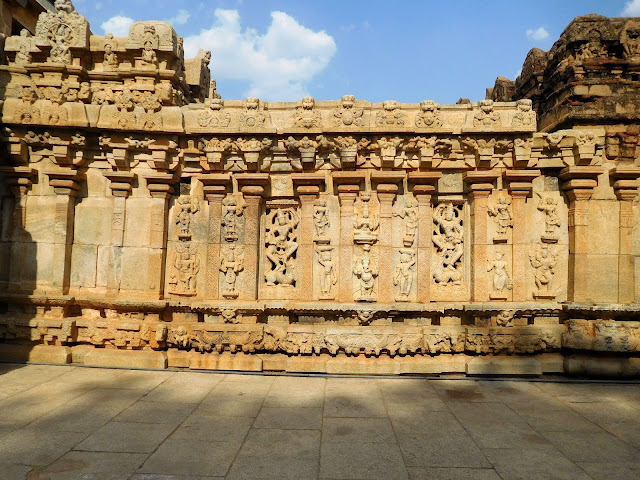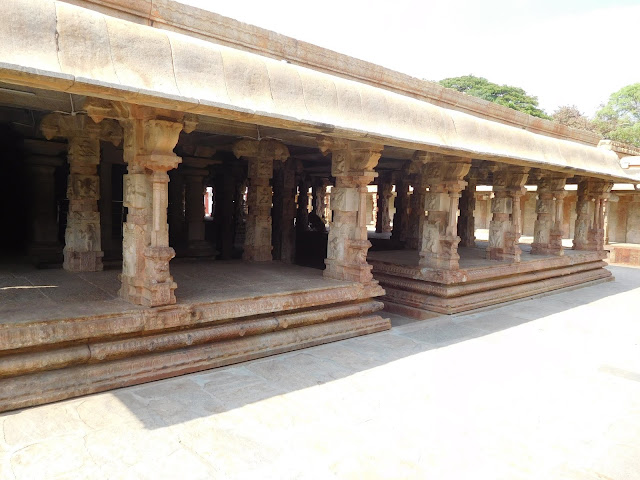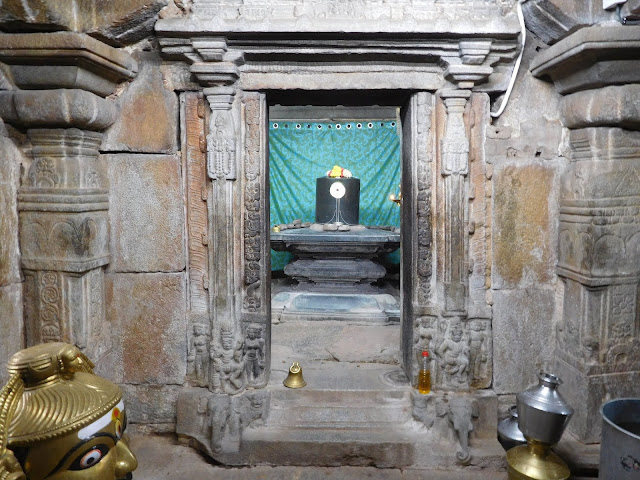The Bhoga Nandeeshwara Temple is located in the Nandi village, at the base of the Nandi Hills, Karnataka. The temple is not very well-known and a only a few people visit it everyday. Yet, it has some of the most exquisitely carved pillars and sculptures in the whole of Southern India.
We visited the temple after going to the Nandi Hills. It can be reached quite easily from the base of the Nandi Hills by driving 6-7 kms through verdant fields and hilly terrains. The drive was short and scenic, but since there were no signboards we had to stop ask around a couple of times to make sure that we were going in the right direction.
The temple is dedicated to Lord Shiva. There are three shrine rooms (garbagriha). The central shrine room is dedicated to Uma-Maheshwara i.e. Parvati-Shiva. The temple was originally constructed in the 9th century by the Nolamba dynasty, and was built upon and enlarged by succeeding dynasties. The environment inside the temple is calm and peaceful, and its a great feeling to be able to walk around undisturbed and appreciate the architecture.
 |
| The majestic Temple Gateway. |
 |
| A Yakshini carving at the entrance. Yakshinis are nature spirits and they are frequently depicted at temple entrances, holding on to a tree branch (salabhanjika), welcoming the visitors inside. |
 |
| Yali (gaja-vyala) protectors carved on the inner boundary wall. Yalis or Vyalas are mythical animals, combining the characteristics of lions and elephants. The Yali symbolism was known to the Indus people as well. For more information, read my article: "The Yali Symbol on an Indus seal and its connection to Kartikeya-Murugan". |
 |
| The passages were presumably areas for the pilgrims to take rest in the shade. |
 |
| A small shrine dedicated to Goddess Parvati in the temple complex |
 |
| The temple has three main components: the spire (vimana), the vestibule (sukanasi) and the outer hall (mandapa). |
 |
| The decorative wall connecting the two spires of the temple. Behind this wall is the third and central shrine called the "Uma-Maheshwara" shrine. |
 |
| The mandapa or assembly hall |
 |
| The mandapa has pillars depicting figures from the mythologies, flora and fauna. There is a very interesting structure in this image - a stone umbrella! I wonder for what purpose it was built. |
 |
| Yali (simha-vyala) pillars in the mandapa |
 |
| Intricately carved granite pillars depicting attendant maidens. |
 |
| Shiva Linga in one of the shrine rooms |
 |
| Each of the two shrine rooms (on either side of the central shrine room) has a monolithic sculpture of Nandi in a pavilion facing the Shiva-linga in the shrine room. |
 |
| Precision carved granite pillars in the shrine room. |
 |
| The edges are so sharp, it is almost as if these granite pillars have been fashioned using lathe machines. |
 |
| The pillars of the kalyana mantapa depict decorative birds and creepers, in addition to deities. |
 |
| The complexity of each of these pillars is quite astonishing. It is difficult to fathom how they could have been fashioned using simple tools. |
 |
| A decorative relief of dancers and musicians outside the shrine room. |
 |
| Relief carvings of attendant maidens on the wall of the Uma-Maheshvara shrine room |
 |
| Relief carving of sages on the wall of the Uma-Mahesvara shrine room. |







Post A Comment:
0 comments so far,add yours